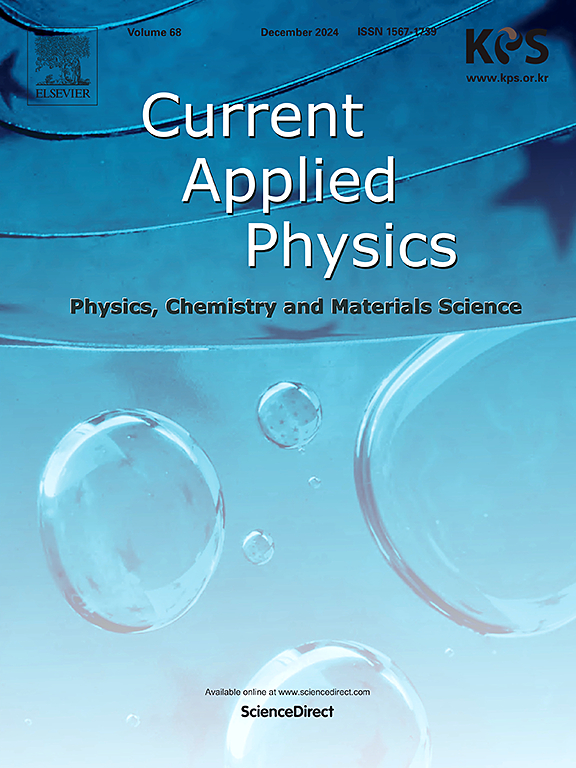基于粒子群优化算法的多功能太赫兹器件优化
IF 3.1
4区 物理与天体物理
Q3 MATERIALS SCIENCE, MULTIDISCIPLINARY
引用次数: 0
摘要
为了拓展太赫兹(THz)器件的应用场景,我们设计了一种由顶层可电调谐石墨烯超材料、中间层二氧化硅、底层相变材料二氧化钒(VO2)组成的太赫兹(THz)多功能器件。采用粒子群算法(PSO)对多功能器件进行结构优化。经过多次迭代,确定了结构参数的理想值:h1 = 6.35 μm, w = 3.93 μm, R = 5.00 μm, L = 21.97 μm。该器件在二氧化钒处于金属态时为石墨烯-介电-金属结构,此时吸收层为石墨烯层。仿真结果表明,该器件在3.805 THz和4.15 THz下完全吸收率分别为99.94%和99.98%,Q值分别为37.04和36.09,对环境折射率非常敏感,传感灵敏度高达1210 GHz/RIU。当二氧化钒处于绝缘状态时,器件实现了等离子体诱导的透明效应,具有优异的慢光性能,群延迟为30.71 ps。本文的设计将为太赫兹探测器、太赫兹天文观测设备、太赫兹光谱仪等新型器件的研究提供更多思路。本文章由计算机程序翻译,如有差异,请以英文原文为准。

Multifunctional terahertz device optimized based on particle swarm optimization algorithm
In order to expand the application scenarios of terahertz(THz) devices, we have designed a THz multifunctional device consisting of an electrically tunable graphene metamaterial in the top layer, silicon dioxide in the middle layer, and vanadium dioxide (VO2), a phase change material, in the bottom layer. Particle Swarm Optimization (PSO) is used to optimize the structure of the multifunctional device. After several iterations, the ideal values of structural parameters were determined as h1 = 6.35 μm, w = 3.93 μm, R = 5.00 μm and L = 21.97 μm. The device is a graphene-dielectric-metal structure when vanadium dioxide is in the metallic state, and the absorbing layer is a graphene layer at this time. The simulation results show that the devices achieves 99.94 % and 99.98 % complete absorption at 3.805 THz and 4.15 THz, with Q values of 37.04 and 36.09, respectively, and is highly sensitive to the environmental refractive index, with a sensing sensitivity as high as 1210 GHz/RIU. When vanadium dioxide is in the insulating state, the device realizes the plasmon-induced transparency effect and has excellent slow light performance, and the group delay is 30.71 ps. In a word, the design of this paper will provide more ideas for the research of new devices such as terahertz detectors, terahertz astronomical observation equipment and THz spectrometers.
求助全文
通过发布文献求助,成功后即可免费获取论文全文。
去求助
来源期刊

Current Applied Physics
物理-材料科学:综合
CiteScore
4.80
自引率
0.00%
发文量
213
审稿时长
33 days
期刊介绍:
Current Applied Physics (Curr. Appl. Phys.) is a monthly published international journal covering all the fields of applied science investigating the physics of the advanced materials for future applications.
Other areas covered: Experimental and theoretical aspects of advanced materials and devices dealing with synthesis or structural chemistry, physical and electronic properties, photonics, engineering applications, and uniquely pertinent measurement or analytical techniques.
Current Applied Physics, published since 2001, covers physics, chemistry and materials science, including bio-materials, with their engineering aspects. It is a truly interdisciplinary journal opening a forum for scientists of all related fields, a unique point of the journal discriminating it from other worldwide and/or Pacific Rim applied physics journals.
Regular research papers, letters and review articles with contents meeting the scope of the journal will be considered for publication after peer review.
The Journal is owned by the Korean Physical Society.
 求助内容:
求助内容: 应助结果提醒方式:
应助结果提醒方式:


